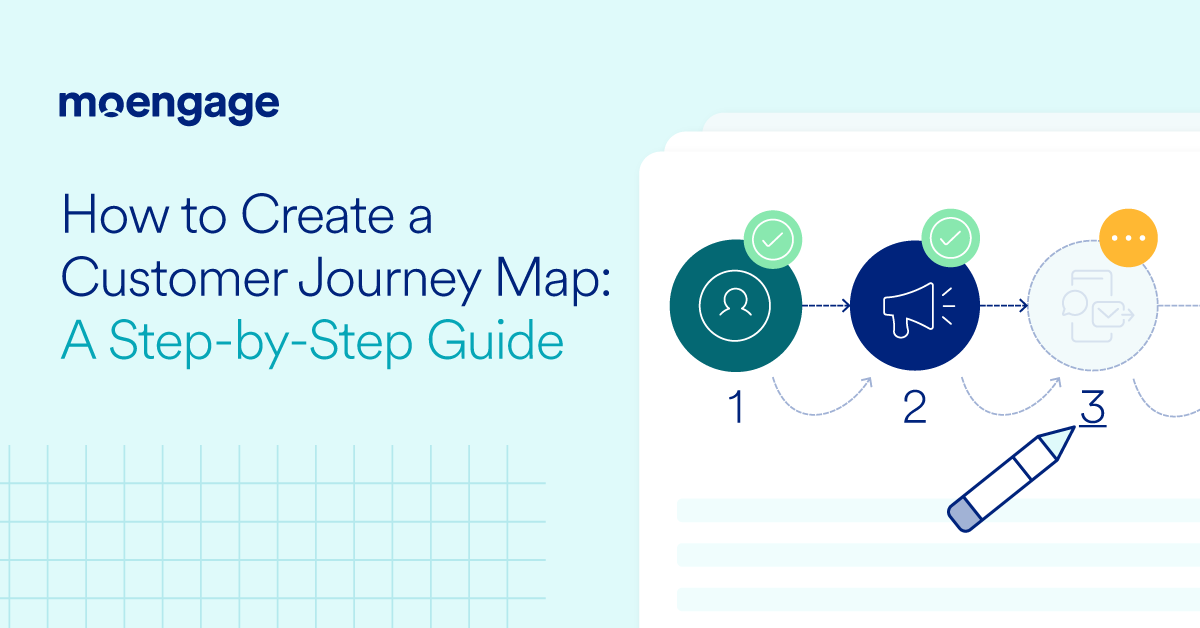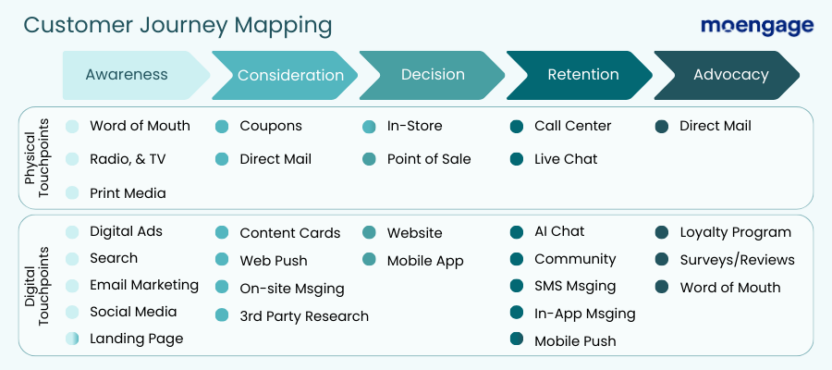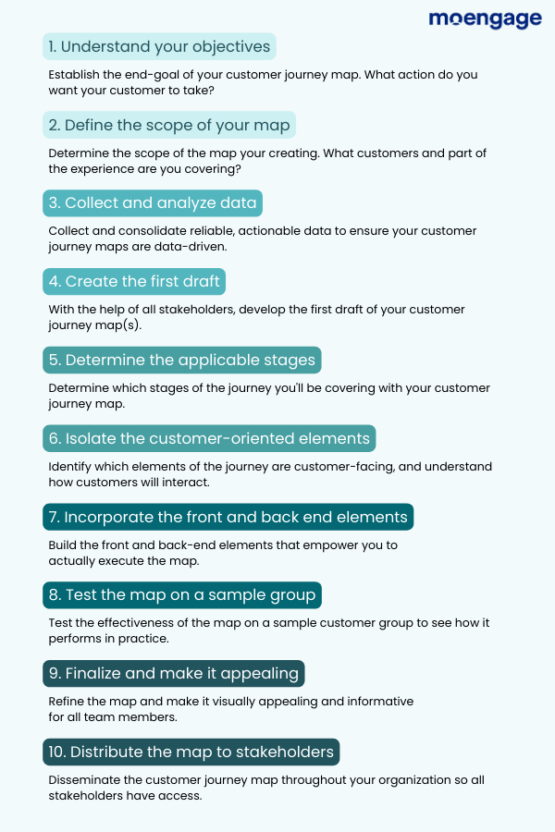How to Create a Customer Journey Map: A Step-by-Step Guide

Reading Time: 13 minutes
For brands to be successful, they have to empower customers to take the actions they want, whether that’s buying a product, subscribing to a service, consuming content, or placing a food delivery order.
But to offer customers the right support (at the right time), brands need to truly understand what motivates and drives their customers. Effective marketers don’t just focus on the desired action, they also focus on how they can help customers achieve their goals easier and more conveniently. By supporting customers through their buying journey, brands are able to engage them more effectively.
When done properly, creating customer journey maps can help brands illuminate customer pain points and find solutions that streamline their experience and keep them on track.
This article breaks down how to create an actionable customer journey map that will activate and engage your customers, and help you to take your customer engagement to the next level.
What is a Customer Journey Map?
A customer journey map is a diagram, flowchart, or illustration of all the touchpoints associated with your customer’s entire lifecycle, including before, during, and after they make a purchase. It helps to reveal exactly where your engagement strategy is helping customers, and where it is hindering it.
This visual representation of how your customers engage with your brand reveals valuable insights on the key touchpoints in their experience and opens up opportunities for improvement.
A customer journey map allows you to reverse-engineer your engagement strategy and find more efficient purchase paths for your customers.
When leveraged effectively, customer journey maps provide marketers insights about areas of friction that can be improved, but also areas of success that can be built upon. This allows them to identify effective cross-selling/upselling campaigns, predict and prevent cart abandonment, and make an array of real-time improvements to leverage this strategy elsewhere.
The following illustration shows the 5 stages of the customer journey, along with critical touchpoints that customers engage with a brand on.

Modern consumers engage with brands via a multitude of touchpoints at various times in their customer lifecycle. Mapping out these potential pathways allows businesses to implement strategic improvements that reduce friction and improve retention.
When creating customer journey maps, most marketers categorize customers into 5 main stages of the customer journey to better analyze and understand behavior patterns across a myriad of digital and physical touchpoints.
- Awareness: Customers aren’t yet familiar with your brand. At this stage, brands are focused on increasing awareness and recognition so that when a potential customer enters a buying cycle, they have a higher chance of being top of mind for consideration down the road. The priority here is to increase exposure.
- Consideration: Here, customers are in the process of choosing a brand and its products and services. Potential customers are trying to identify what differentiates one brand from another, so they can make an informed decision about which brand or product is best for them. At this stage, the goal is to nurture leads by showing them what you have to offer and what makes your brand unique.
- Decision: Customers are poised to make a decision on a brand or product. Customers have shortlisted options, based on their research and brand comparisons. At this point, the goal is to ensure that your brand, product, or service is what stands out (and gets picked).
- Retention: Just because customers choose a brand doesn’t mean they have to keep using it. After customers use a product or service, they’ll have to choose whether to keep using that brand or change to an alternative. At this stage, it’s important to highlight your brand’s unique value and keep customers actively engaged and interested.
- Advocacy: Now that you have loyal customers, you want to ensure they refer more business your way. Efforts at this stage should focus on building these loyal customers into brand advocates who will stick with you through thick and thin and even promote and recommend your business to their friends and family.
People, and their thoughts, are rarely linear. Customers often interact with multiple channels and in a myriad of ways before they reach their point of decision-making.
Due to this, customer journey maps need to consider the diverse ways customers engage and factor in potential cyclical loops to fully capture the customer journey pathways. Analyzing omnichannel engagement helps your team identify friction points in the customer experience so you can make improvements that increase engagement.
How To Create a Customer Journey Map in 10 Easy Steps
Creating a customer journey map can be complex. It requires the ability to analyze customer behavior from quality data and clear team objectives. Numerous drafts are often required before you are able to test and ensure that the map is realistic to the customer experience and suits your purpose. A proper customer journey map must also be visually effective and understandable for the teams that rely on it.
We have broken this process down into 10 comprehensive steps to get you started on the path toward improved customer engagement and retention.

1. Understand your customer journey mapping objectives
To build a useful customer journey map, brands need to start with a simple question. What is the objective of the customer journey map? Or, in other words, what action do you want customers to take and what aspects of the customer experience are you hoping to shine light on?
A single customer journey map won’t guide all your customers where they need to go. Instead, you’ll have to create multiple unique customer journeys that reflect the varied objectives of your customers. It’s crucial that these customer journey maps are focused on the end goal, or they’ll cast too wide of a net (and fail to deliver results).
By focusing your customer journey map around clearly defined objectives, you’ll ensure that they help you elicit the intended action from your customers. You’ll also ensure that you’re equipped to measure how well you’re able to achieve the intended outcome for your customers so you can review, analyze, and improve the process.
2. Define the scope of the journey mapping
After you’ve agreed upon the objectives, it’s time to identify the scope of the mapped journey. What customers will your map focus on? Will it focus on creating a captivating customer onboarding process, where you skillfully nurture anonymous web users into loyal customers? Or perhaps your map will set its sights on the ongoing customer experience post-acquisition, ensuring their satisfaction knows no bounds.
Specificity is important here because casting the net too wide will make the map less effective. As they say, to chase two rabbits is to catch none.
To start with, stick to no more than three customer personas to frame the journey map. With that framing in mind, you can begin to research and analyze the data already available to your business to inform the customer journey map.
A clear scope is critical to determining your team’s next steps, such as more research, channel refinement, checkout design, or altered messaging. Determine what story will unfold through your marketing decisions.
3. Research, collect data, and analyze
To build customer journey maps that accurately represent the customer’s experience, they need to be based on facts rather than expectations or wishful thinking. Marketers need to be able to make data-driven decisions that enable them to optimize engagement. And in today’s landscape, customer journeys are increasingly omnichannel — which means your data should be omnichannel as well.
Brands will want to look for any existing data they may already have to draw insights from, whether that’s customer survey feedback, call logs, focus group studies, industry studies, or competitor analysis. Beyond that, you’ll want to conduct your own quantitative and qualitative research to round out your understanding of customer behavior.
Contextual inquiry is another powerful tool in this process. It starts with observation of your customers as they interact with your brand, access your services, or utilize your products in their everyday lives.
As they are encouraged to use your products or access your services holistically, you can acquire more refined insights than if you asked them to complete a survey that disrupts their routine. Specific interviews with small sample sizes can help your team refine their assumptions leading into the workshopping phase.
The collected data can then be used to construct customer segmentation profiles and approximate customer personas to act upon. Personas are constructed based on customer demographic and psychographic information, as well as their emotive and purchasing behavior.
Making use of customer segmentation and personas provides a valuable lens through which to shape your customer journey map. Think of personas as archetypes of your customers that provide valuable insights into their behavior and needs. They serve as a powerful tool for your organization to truly understand your customers in an effective way.
4. Workshop the first draft of the map with different teams
Creating the initial draft of the map requires cooperation from multiple teams within the organization. Every team will have different insights into how the customer interacts with the brand. The cooperative effort across these teams will be where you capture the best insights on how to improve the customer experience.
However, true, data-backed customer experiences should never be discarded by anecdotal suggestions. Your team’s insight is valuable, but it won’t always align with the authentic customer journey. That’s where testing comes in.
Every stage in the journey needs to be accounted for in detail, and team cooperation is crucial. By combining feedback and observations from various business branches, such as product design, operations, or go-to-market, the outline of the customer’s journey will finally start to take shape.
Sales and support branches will be invaluable during this step of the process as they contribute directly to the customer experience and engage with customers in the most direct way.
5. Determine the stages of the journey
Identify which stages of the customer journey apply to your map.
Keep in mind that not all journeys will include all five stages. Some journeys may end at a sale, and will not require a post-purchase stage. Others may even end at engagement; media companies may rely solely on ad revenue, meaning customers never make a ‘purchase’ or buy a subscription.
Other journeys may only look at existing customers, and may not require the awareness phase to be factored in. The stages depend on the objective of the journey map you are creating and the intended action you want the customer to take.
These stages will determine the entire framework of your customer journey map, acting as the foundation you build upon. This will help you keep your map structured as you develop it.
Always keep these stages in mind as you build out your map so you are always conscious of the type of engagement you are trying to elicit at the various stages of the customer journey.
Now that you have this framework in place, you can begin to map out the customer journey itself.
6. Identify the customer-oriented elements
Only now is it time to actually map out the events — or interactions — in the customer journey. You’ll need to map out every single individual interaction the customer takes, whether that interaction is measurable or not.
Customer-oriented elements capture the crucial aspects of the journey experienced directly by the customers themselves. They provide insights into their needs, emotions, and interactions. This aspect of the map will be informed by your earlier research and contextual inquiries.
Remember, it’s always important to keep the end objective in mind. It’s often easiest to start at the end and work your way backward to the beginning. By the end, you need a complete journey mapped out, with every single interaction a customer will take throughout the process represented.
No matter how you choose to map out the journey, it’s critical that you consider how a customer would realistically travel through the experience, and not just how you want them to travel through it. Think critically from their perspective to understand how they’ll proceed through the defined journey, and even anticipate potential friction points along the way.
It’s also imperative that you think about what metrics and KPIs you can use to measure engagement throughout the journey. This will enable you to quantify retention and churn at each stage so you can identify strengths and weaknesses (and make the necessary adjustments!).
7. Work in the front and back end support elements
Now that you’ve outlined the process’s customer-facing elements, it’s time to identify the front- and back-end components that enable your team to bring it all together.
Front- and back-end support elements encompass the systems, people, and processes that help customers reach their goals. Some of these elements directly impact the customer, but most work behind the scenes to ensure a seamless and enjoyable customer experience.
While these are critical components of the customer journey, they can’t be the elements that guide it. Instead, brands need to ensure that their customer journey is customer-centric and then build these front and back-end elements around what works best for their customers.
8. Test the map with real customers, and iterate until it works
Frictionless consistency doesn’t happen overnight. You will have already anticipated what you think issues are, but that won’t always be the case in reality. Once you’ve defined the stages of your customer map, you need to validate each of those steps through genuine testing.
Choose a representative sample to test with; broad enough that it represents the diversity of your customers. If possible, use direct customer observation or contextual inquiry to actually see how customers interact with (and respond to) your orchestrated journey.
When this isn’t possible (and it often isn’t), you’ll need to rely on omnichannel analytics that gives you detailed data on customer demographics and behavior.
Test how well your customer journey represents accurate customer pathways and how effectively it drives engagement. It’s important to update and continually iterate the map to make it more accurate and provide marketers with more useful data.
Expect testing to illuminate problems with your map. Identify inconsistencies and promptly act on them. Don’t forget what the teams are aiming for. Clear goals in testing help ensure that things stay on track. You don’t want distractions from the real insight: where you will focus your efforts to improve.
9. Finalize, and make it visually appealing
Effectively visualizing the qualitative and quantitative insights you have revealed helps make the customer journey map actionable for your team.
Graphics should be clear. Diagrams and graphs might be necessary to illustrate key information and actionable touchpoints. Clear, comprehensive data visualization empowers marketers to make faster, more accurate decisions about the customer journey.
Digital collaboration platforms like Miro offer templates that brands can use to create visually compelling customer journey maps that teams can leverage to improve the customer experience and maximize engagement.
A visually appealing and informative customer journey map ensures that all stakeholders can easily understand, interpret, and utilize it to maximize engagement at various stages in the customer lifecycle and at all touchpoints.
10. Distribute the map within your organization to those who benefit from it
Now that the map is ready for distribution, teams can use it to tackle points of friction for the customer,better break down their information silos, and collaborate more effectively. Incorporate the use of the customer journey map in developing future applications or any upcoming changes to your channels, such as mobile or web.
As the map facilitates improvement, it may be beneficial to draft similar maps with differing goals and customer personas in mind. Using customer journey maps to shape how teams approach problem-solving helps ensure productive uniformity within your business.
Customer journey maps can become important touchstones during team and development meetings. Use them to facilitate discussions and motivate improvement across departments. By engaging in these conversations, enhancing the overall customer experience will become an internal constant that keeps your business competitive and driving toward success.
Tips for Building a More Strategic Customer Journey Map
Customer engagement strategies live and breathe as your audience does. There will always be ways to improve.
The following are some additional tips to ensure that your customer journey map remains actionable and rewarding to your marketing and customer engagement efforts.
Make it omnichannel and consider all touchpoints
Customer experiences are increasingly omnichannel. Customers interact across a myriad of touchpoints, both online and offline, and they expect a familiar experience across all of them.
For your customer journey maps to actually help you understand and improve the customer experience, they need to accurately reflect the ways customers interact with your brand. Ensure the map you create accounts for the various channels customers can use to connect with your brand, and encapsulates the myriad of pathways customers can take.
To reflect this range of pathways, teams will often need to develop multiple customer journey maps that cover the different channels and touchpoints available to your customers.
Implement elements of personalization throughout
Customer journey maps aren’t developed on a one-to-one basis but instead often target customer segments and unique personas. That being said, personalization is crucial for increasing traction and engagement with your customers.
Think critically about where in the customer journey you can implement elements of personalization that will resonate with customers on a deeper level.
Consider where you can add these elements to the customer journey, as well as how to execute the personalized component. Identify where personalization will have the greatest impact, and then determine how you can execute experiences and campaigns that personalize the right elements of the customer journey.
Take a customer-centric approach
It’s true that you want to design customer journeys to encourage customers to take the actions you want them to take. But to maximize engagement, you need to build customer journeys based on how customers actually behave.
Don’t just build elaborate, wishful journey maps that fail to reflect how customers truly engage with your brand. Instead, take a customer-centric approach that allows you to develop customer journey maps that truly reflect how customers interact with your brand, empowering you to maximize engagement.
Apply decision trees
As you apply your customer journey map, it will directly influence future production decisions. Pairing decision trees with your customer journey map provides fresh opportunities in the development phases for new products and services. Decision trees can help you hone segmentations of the personas you have developed for your map.
As decision trees help marketers analyze relevant variables that impact customer behavior, they can be used to branch off and brainstorm touchpoints that have already been established in your map.
If your team is focusing on email campaigns and how customers interact with that touchpoint, decision trees can help hone in on specifics for A/B testing and recommendations to customers in the retention phase.
Keep testing and iterating
Continue to monitor customer interaction. Don’t take for granted that the journey map will remain accurate and relevant over time without effort. A static map that doesn’t change as customers do won’t serve your business in any real, material way.
Enhancement and revision are to be expected and encouraged. Use dynamic A/B testing to compare the performance of different journey flows, to find the most relevant ones for different customer segments..
Leave lines of communication open to customers so that as they evolve and their purchase patterns shift, your team can be primed to adapt. Build moments of re-evaluation into your development and marketing workflow so that needed updates don’t get swept under the rug over time.
Guide Your Customer Journey Maps With MoEngage
Customer journey maps allow businesses to implement strategic improvements to reduce friction and improve retention. A customer journey map is not a magical solution that solves all problems at once, but it is a crucial tool that empowers teams to deeply understand customer interactions, identify weaknesses in your campaigns, and make significant improvements that increases engagement and retention.
Prioritizing customer value, and shaping your brand decisions in a customer-centric way is a necessity in the modern market.
Our platform aims to be your true north on the road to customer engagement. To understand how we commit to putting customers first and enable you to implement your customer journey maps with perfection, request a demo today.









